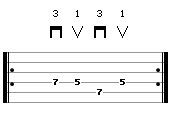Lesson 8 - Exercises for Working Out Movements Around Nearby Strings
- Intro
- Exercises
- Guitar Licks
This third lesson on the Alternate Picking is crafted to help you improve your playing at moments when your fingers run around adjacent strings.
The series of short exercises that come first is tightly focused on just this subject, usually it's easier and quicker to achieve results practicing over a few-note-sequence.
Here's a tip: Whenever you find an area in a solo or riff that overwhelms you, you can cut it from the flow, analyze and concentrate your practice just on this area for some time, it will be the exercise that is specific to you.
I recorded the following exercises long time ago when I was using only 3 fingers to press the strings, since then I returned back to using the pinky finger as well. So I displayed both types of fingering.
Exercises











Here, there are 3 note in the repeatedly played sequence, because we use alternate picking, each even time we play the sequence, the plectrum's movements will invert.
Let's track them:
- The odd time you pass through the sequence your plectrum goes: down, up, down.
- The even time it goes: up, down, up.
Another thing to note, is that despite I advised you to generally use the fingertips to press the strings in the first lesson, here is an example where it is OK to lean your finger in a way that it can press the 4th and the 3rd string with its pulp without need to move around.
You can do this in any similar situation where two notes located at same fret on immediate strings.


You can use 1st and 2nd, 2nd and 3rd, 3rd and 4th finger.
This exercise helps to improve walking across multiple strings.
It's not really important where you begin on the fingerboard, just move the pattern forward fret by fret, after that you can go back toward the guitar head.
If you feel that playing with one pair of fingers is more difficult that with the rest, play it more often with the pair you find it is more difficult to focus more on the problematic areas in your performance.

You can begin playing this exercise at any higher fret, moving the pattern of notes 2 frets down towards the guitar nut. This 2-fret-move is what makes it sound jazzy.
Guitar Licks
After the exercising, have some fun with the alternate picking licks:



This lick might feel a bit tricky.
First, it's played with triplet notes. When there are 2 adjacent notes at the same fret on different strings, I lay the pulp part of the finger (index or ring) to press those strings, just like in the 11th exercise on this page.
At the end, after letting the two simultaneously picked notes ring I glide the fretting hand towards the guitar head.
